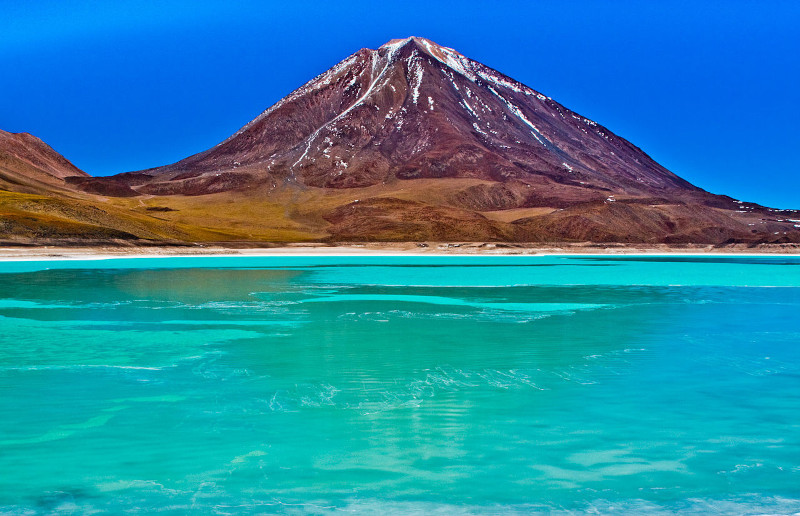Laguna Verde Facts
- In the native language of the region in which it formed, this breathtaking body of water most frequently goes by the name of Laguna Verde. This translates into english literally as green lake. The name’s certainly descriptive, and appropriate for the formation.
- Despite its extreme beauty, tourist activity in the region remains limited, though only in relative terms. It actually ranks among the most frequented of locations for tourist visits in the country in which it lies. The reason for that’s relatively simple, however.
- The body of water lies within the confines of the Eduardo Avaroa Andean Fauna National Reserve. This makes it a somewhat remote destination. However, the fact that this places the lake in the approximate middle of the Andes further limits visitation.
- Augmenting its visual appeal further is the surrounding landscape, as one can plainly see from this image. That’s because it clearly lies at the base of a majestic mountain. That mountain, though, is actually the volcano bearing the name of Licancabur.
- Being presently considered as dormant, having this as a backdrop merely enhances the magnificence of Laguna Verde. The combination leaves the site generally considered by many to be among the greatest geological marvels of this region of the globe.
Related Articles
Laguna Verde Physical Description
The mesmerizing beauty of Laguna Verde exists on its own merits, wholly regardless of any other physical characteristics. That fact’s plainly obvious to any and all who visit its shores. Yet its other traits bear mentioning in any discussion of the amazing site, of course.
The incredible body of water further has a highly elongated overall shape. It also has an irregular, and somewhat variable, outline. The lake’s also divided into two sections by a relatively narrow causeway. This provides it with a stretched-out figure eight shape.
It also manages to compress such natural beauty into a small site. That’s because, aside from that appeal to the eye, its other attributes remain modest. Thankfully, though, Nature has never felt restricted to combining size and beauty in its many constructions.
The marvelous Laguna Verde possesses a total average surface area of approximately 2.9 sq mi (7.5 sq km). This varies slightly, of course, due to such factors as rainfall and evaporation rates. It remains quite shallow, however. The lake has an average depth of 18 ft (5.4 m).
It’s the tantalizing hues of the body of water that garner the most attention, however. This comes from the suspension of high levels of several minerals, including arsenic! This thus results in a range of brilliant colors that varies from turquoise to a dark emerald shade.
Laguna Verde Location, Formation, and Nature
The eye-catching lake known appropriately as Laguna Verde formed in a region of the globe well known for its abundance of geological marvels. That’s due to the fact that natural processes created it in an area of what now constitutes South America.
More precisely, the lake sits in the country of Bolivia. It’s also quite close the border with the country of Chile. This places the natural wonder in the Sur Lípez Province of the Potosí Department. This puts it in a remote, and comparatively rugged, region.
Technically considered a salt lake, it further formed in a naturally occurring drainage basin, quite close to the dormant volcano that so dominates the local skyline. It also sits at an astounding altitude of 14,140 ft (4,310 m). Snowfall therefore forms part of its source.
The majority of its water, however, comes from another origin. Geothermal activity still present beneath the site provides it with a natural inflow of water from hot springs. Despite the altitude, its water therefore maintains an average of 55-68 F (13-20 C).
Due to the slight toxicity of its waters, wildlife is absent from Laguna Verde. It nevertheless has other marvels to draw the tourist, in addition to its green shade. Numerous geological structures, known as stromatolites, dot the region, though they’re now inactive.
Researchers estimate that these structures formed between 20,000-10,000 years ago, though. Presently, however, other, smaller structures of a different nature still appear. These consist of microbial mats, formed by the actions of specialized bacteria in the water.
Features Sharing Its Region
Check out our other articles on 5 Vividly Vibrant Vines, African Monarch, Fraser Island, Blainville’s Beaked Whale, European Honey Buzzard, Rough-nosed Horned-Lizard

